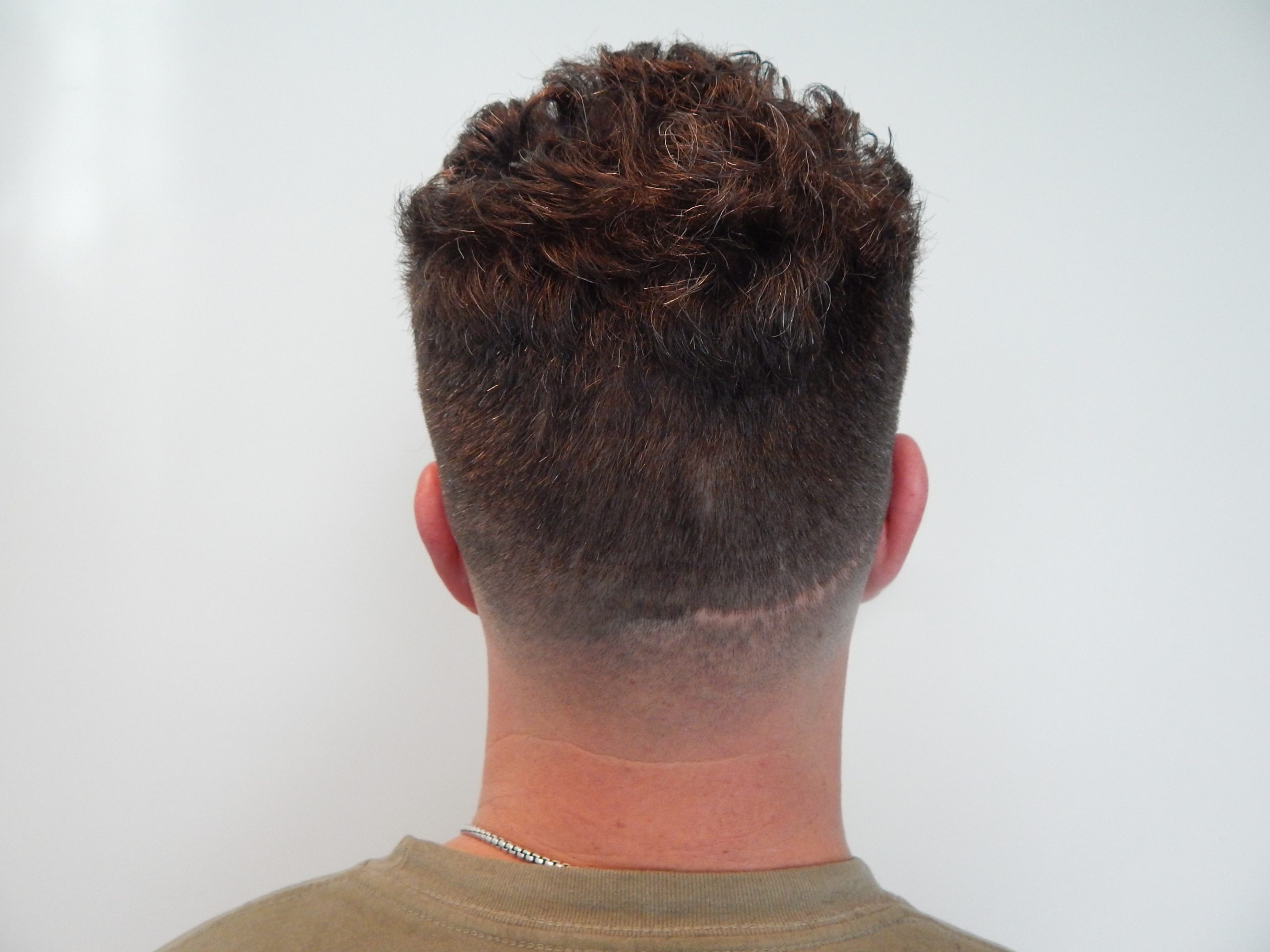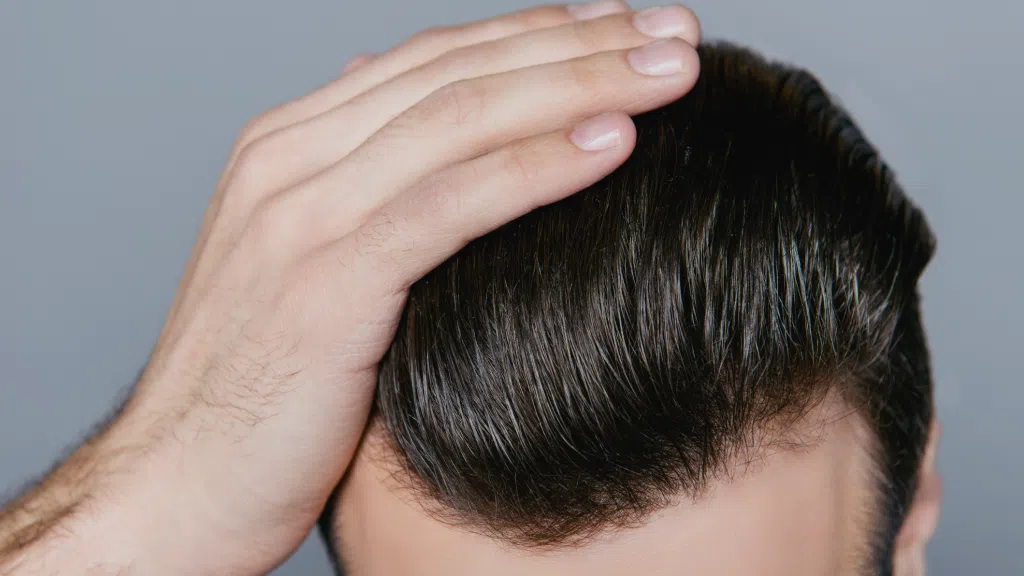Hair transplant surgeries have helped millions regain their natural hair after struggling with hair loss. While safe and effective, both FUE hair transplants and FUT hair transplants may leave patients with permanent visible scars.
You may wonder, “Are there ways to hide this scar”? You could wear a hat or head covering, but that’s not always ideal. Plus, you’ll want to show off your new hair!
Thankfully, there are methods to reduce and even remove scarring from the scalp. Here’s everything you need to know about treating hair transplant scars.
What is Scar Tissue?
Scar tissue is a collection of cells and collagen that covers the site of the injury. This forms when normal tissue is destroyed. Even though it might not look nice, a scar is the body’s natural way of healing. It repairs the damaged skin and protects an open wound from bacteria and infection.
When our body first bleeds, blood clots form a scab over the wound. Fibroblasts then build restorative scar tissue beneath the scab formation. This process destroys any existing hair follicles, which will not regenerate. This means your hair won’t grow back in the scarred area.
For those with a scar from a hair transplant, the scar on the scalp creates a hairless area on the back of the head.
Does a Hair Transplant Always Leave a Scar?
Yes, any type of hair transplant will leave scarring. However, hair surgery scars are different depending on which type of hair transplant procedure you get and the skill of the surgeon.
- FUT (Follicular Unit Transplantation) transplants do leave a linear scar on the back of the scalp.
- FUE (Follicular Unit Extraction), in comparison, leave you with dot-like scars. Keep reading to learn why this is the case.
How visible or noticeable a scar is depends on the individual. Factors like age, scalp condition, genes, and surgical technique can affect the outcome.
How Is the FUE Method Different from FUT Transplants?
In a Follicular Unit Extraction (FUE) procedure, the surgeon uses a punch tool to harvest individual hair follicles. They will then transplant these follicles to other areas of the scalp. This produces many small, dot-like scars, unlike a linear scar on the back of the head.
In a Follicular Unit Transplantation (FUT) procedure, the surgeon removes a strip of the scalp from the back of the head. In turn, they harvest donor grafts of hair from the strip and then transplant them back onto bald areas of the scalp.
Unlike the FUE dot-like scars, an FUT hair transplant can create an undesirable linear scar on the back of the head, especially when performed incorrectly or by a inexperienced surgeon. However, when comparing the two techniques, scarring is far from the only factor considered when deciding which method to choose. Ultimately, the best solution depends on each person’s personal hair loss situation.
What Treatments Are Available to Treat Scalp Scars?
If you’d like to minimize or reduce a scalp scar from a hair transplant, here are a few effective methods that work best.
1. Topical Serums and Creams
Silicone-based creams or patches designed for surgical scars are also effective for hair plug scars. They work by softening and moisturizing the tissue. Retinoid creams and serums can also improve the appearance of scars. They encourage cell turnover and the production of new skin cells for healthier skin appearance.
2. Laser or Light Therapy
Laser therapy can reduce the appearance of scars after a hair restoration procedure. This type of therapy removes damaged layers of skin, stimulating collagen production and new skin growth. Light therapy can also produce similar results by using LED technology.
3. Microneedling
Microneedling (aka collagen induction therapy) uses tiny needles to create microscopic punctures in the skin. This causes your skin cells to react by producing more collagen and elastin. This process leaves your skin stronger and softer than before.
4. Scalp Micropigmentation
Scalp micropigmentation can disguise hair transplant scars by shading in the surrounding areas of the scalp. The procedure is similar to receiving a tattoo. However, you must go to a trained professional for realistic and natural-looking results.
5. Essential Oils
Scientific research shows that certain essential oils can treat hair transplant scars as well as other treatment options. This could be a great option if you prefer a less invasive scar treatment. Some great essential oils for scar healing include helichrysum, lavender, tea tree, and chamomile.
Remember to consult your doctor before using essential oils, as they aren’t suitable for everyone. If using essential oils, remember to always dilute them in a carrier oil before applying them to the skin.
6. Scalp Massage
A scalp massage stimulates blood flow and encourages scar softening. Combined with other non-invasive treatment methods, it can help make your hair transplant scars less noticeable.
Remember, these options can typically only reduce the visibility of a scalp scar. Once you have scarring from a hair transplant procedure, it may never fully go away.
7. Hair Transplant
A hair transplant procedure is an effective method that can be used to remove or minimize a scalp scar. Working with a hair loss doctor, a patient can decide between an FUT or FUE hair transplant, and choose the right technique based on their unique situation and objectives.
8. Scar Revision Procedure
In some cases, the scar tissue might not sustain hair growth. In those cases, a hair loss doctor may recommend a scar revision procedure instead of a hair transplant, which removes the damaged tissue and then re-sutures the scar. With this procedure, you can achieve a significantly smaller and nearly undetectable scar.
Comparing Hair Transplants and Non-Surgical Methods
Most non-invasive or minimally invasive methods are inexpensive, and some can be done right at home. If you want to treat a scar more effectively using a non-invasive method and get natural-looking results, laser light therapy may be the solution – however, a downside to this method is that it is significantly more expensive, typically ranging from $300 to $3,200.
Many people will opt for a surgical method for long-term, natural-looking hair transplant results. An FUE hair transplant surgery is the best way to fix scalp scarring for permanent results. However, there may be certain instances where an FUT method would be the better option.
How Does Hair Transplant Scar Repair Work?
Depending on the type of scar tissue an FUE or FUT scar revision may be recommended for optimal results for addressing scarring from a previous hair transplant.
For FUE, the surgeon implants hair follicles from grafted donor hair directly into the scar tissue. However, this procedure is difficult and can take longer to complete than a regular transplant. The surgeon has to work with a reduced blood supply and support tissue in the area of scarring.
Scar tissue can also leave your skin stiff, with no existing hair follicle pattern to work with. In certain cases, the scar may be too thick to work with, or “hypertrophic”. In this case, the lack of blood supply means grafted hair can’t grow or function adequately. In such cases the optimal solution is an FUT scar revision procedure. This procedure entails removing the damaged tissue and then re-sutures the scar to create a thin nearly-undetectable linear scar greatly decreasing the visibility once healed.
Work With An Experienced Doctor at Natural Transplants
At Natural Transplants, we provide hair transplants for scar revisions to treat a variety of scars – whether it’s from a hair transplant or another previous cause.
Get your free consultation to discuss your options with a licensed doctor. Based in Fort Lauderdale and Washington D.C., our clinic works with men and women nationwide and globally.


